If you think a war with Russia is all we have to worry about, think again.
The US just pulled the most significant provocation of war since the Cold War.
On October 7, Washington banned the US and its allies from exporting microchips and their technology to China —a severe escalation that we predicted back in July.
But what the media reported is just the “official” tip of the iceberg.
What happened off the record, in effect, paralyzed all of China’s chip sector and potentially slowed its development by a decade. Overnight.
With his back to the wall, China’s Xi Jinping – who just secured his third term – may now have no choice but to respond.
But how?
We’ll try to answer that today, but first, let’s talk about the semiconductor trade war.
China’s crippling chip industry
On October 7, the US Department of Commerce slapped an all-out embargo on all China-bound chips.
In short, the new rules prohibit American chip makers from selling chips and their manufacturing equipment to China. Even allies that make chips using American technology in their assembly line will have to obtain licenses to ship to China.
In fact, ASML—the world’s only company that manufactures the Extreme Ultra Violet (EUV) machines used to produce the most advanced chips—has stopped providing services to its Chinese clients:
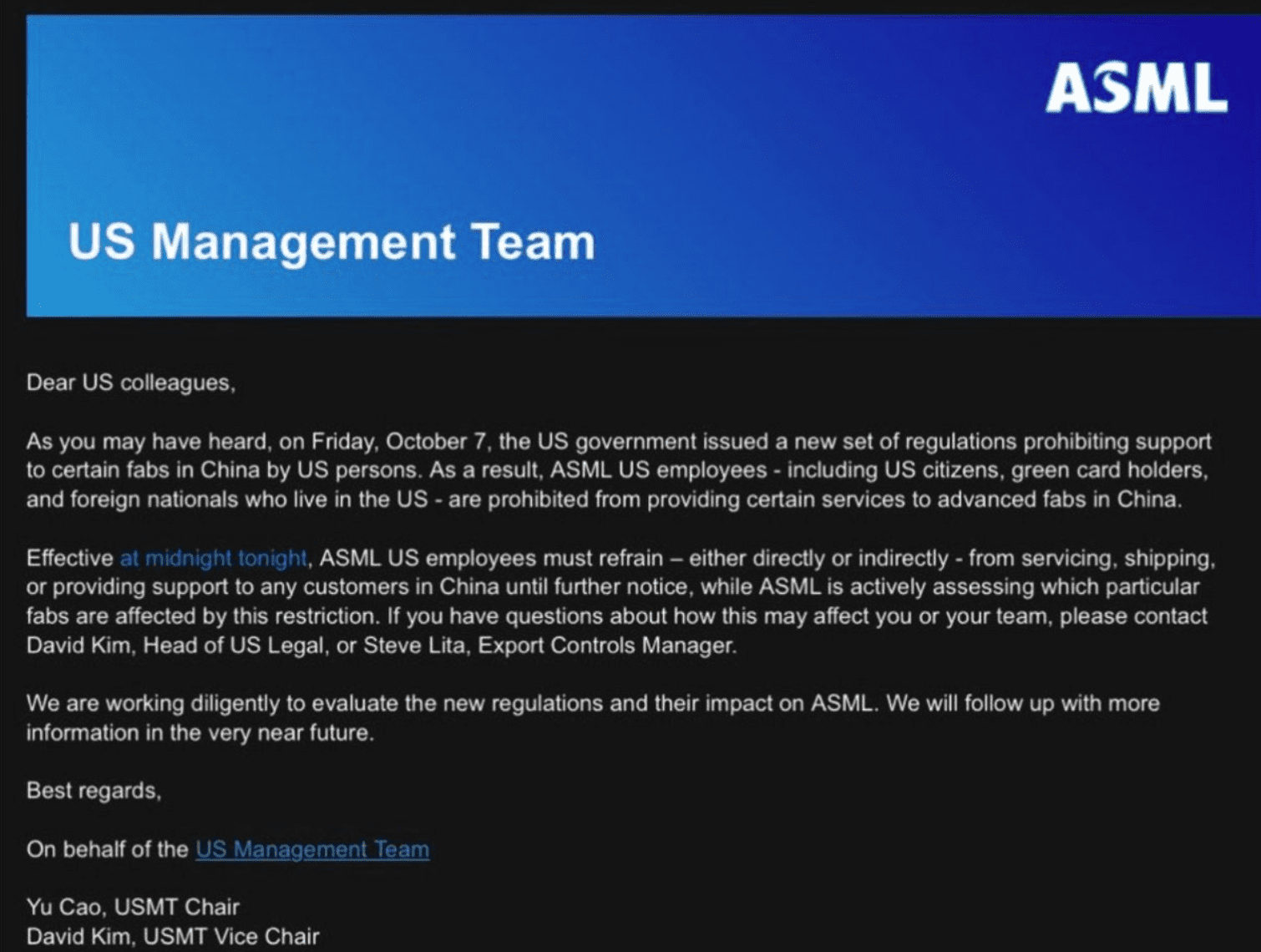
These ASML-made EUV machines are required to produce all of today’s modern chipsets. And by many estimates, ASML will have a complete monopoly over them for at least five years.
This is why the US has long been pressuring ASML to stop trading with China.
In 2019, Trump banned the Dutch government from selling these machines to mainland China.
And now Biden has compelled the company to cut all support and services.
The justification for this protectionism is that China will use these advanced chips to make AI weapons and surveillance technology.
Via US Department of Commerce:
“The PRC has poured resources into developing supercomputing capabilities and seeks to become a world leader in artificial intelligence by 2030. It is using these capabilities to monitor, track, and surveil their own citizens, and fuel its military modernization,” said Assistant Secretary of Commerce for Export Administration Thea D. Rozman Kendler. “Our actions will protect US national security and foreign policy interests while also sending a clear message that US technological leadership is about values as well as innovation.”
In other words, fearing that China will beat the US in the AI game, the Biden administration has effectively bound all American companies and its foreign partners to collectively embargo China.
And those are just the “official” measures.
In a Twitter thread translated from a Chinese tech insider, Jordan Schneider, a closely followed China analyst, revealed the real scale of Biden’s initiated trade war with China.
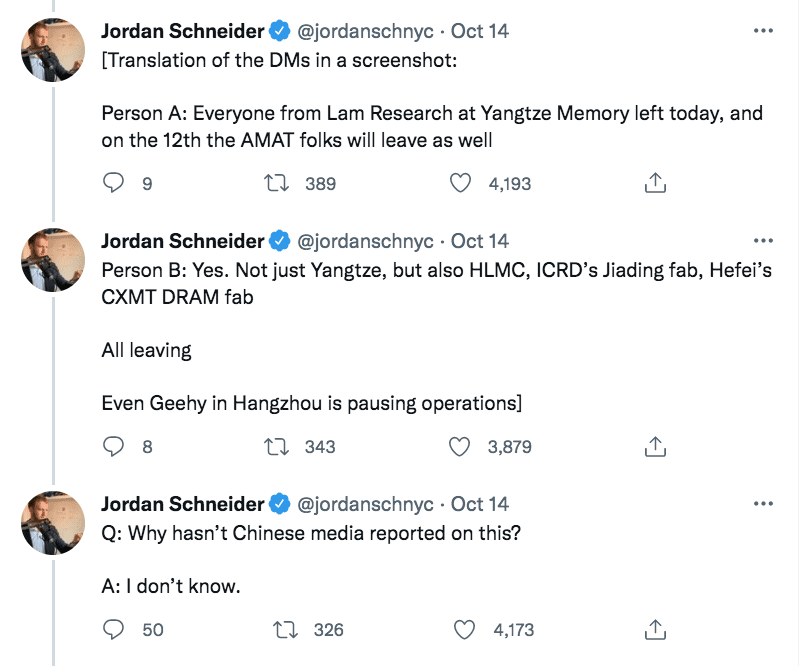
Long story short, all American citizens who worked in the Chinese chip industry received the order to quit immediately or lose their American citizenship.
And just like that, the entire American staff in China resigned almost overnight.
As a result, since October 7, China’s semiconductor industry has been paralyzed.
As Schneider tweeted, “China’s semiconductor manufacturing industry was reduced to zero overnight. Complete collapse. No chance of survival.”
Why chips are so important for China?
A few decades ago, chips were just this niche, high-tech thing. But that technology has now “computerized” almost every gadget in our lives and have become a staple commodity.
Even things as mundane as kettles and lightbulbs have microchips in them.
Now, if you want to make a kettle that displays the water temperature on an LCD, you need a microchip. But for something so simple, you can use microchip technology that has been around for decades.
But if you want to build gadgets with more computing power, you have to use chips built using the 10nm (or less) process.
For example, Apple’s new iPhone 13 is powered by TSMC-made 5nm class chips.
But even the smallest chip in an iPhone isn’t enough to fully power next-gen technologies like AI or quantum computing. By many estimates, the 5nm process is the bare minimum to tap into these technologies.
This has vast military implications.
AI-driven missiles, artillery, autonomous combat machines, and even robo-infantry are the future of warfare. And all of these future weapons will run on 5nm or smaller chips.
Losing access to these chips today is like running out of steel during WWII. No matter how far ahead you were in weapon innovation, if you didn’t have plate steel to piece together combat machines, you couldn’t fire a single shot.
China is emerging as the global leader in AI, and XI Jinping wants to use its tech superiority to modernize its arsenal. But just because he can innovate, it doesn’t mean he can produce that technology at scale.
And that’s China’s Achilles’ heel.
As I wrote in “A Battlefront for the New Global Order”:
“Last year, Alibaba designed its most advanced 5nm Yitian 710 chip. Baidu, China’s Google, released a 7nm chip called Kunlun 2. And Oppo, the Apple of China, is reportedly working on a revolutionary 3nm circuitry.
But while China can design chips, it doesn’t have leading-edge foundries to produce them at scale. So all they can do is contract TSMC and a few other makers to manufacture their designs.
Industry experts think it will probably take a decade or so for China’s chip foundries to catch up to TSMC – and by then, there may be even better technologies, making China always a few steps behind.”
That’s right.
It might take China a decade to build a self-reliant domestic chip industry. In the meantime, it has to source chips from elsewhere…peacefully or possibly by force.
Will China invade Taiwan for chips?
EUV foundries are the next battlefield in the West-China confrontation.
And the world’s biggest EUV foundry sits on the west coast of Taiwan—China’s long-sought invasion target.
As we mentioned in July, Taiwan is home to the world’s most important company and largest semiconductor maker, TSMC. It prints over half of all chips globally for tech giants like Apple and Samsung.
So naturally, all the pundits jumped to the conclusion that China would invade Taiwan and take over TSMC foundries.
But the thing is, China’s solution to chip dependency isn’t as simple as invading Taiwan.
For starters, being on the western coast, TSMC probably falls within China’s artillery range. And if China sets out to fully invade Taiwan, not just spook it, TSMC could become collateral damage.
Even if China invaded Taiwan without blowing up TSCM, it couldn’t make use of it for long.
While TSMC has the world’s biggest chip production facilities, it still sources most of its manufacturing equipment from the West, including the Netherlands’ ALMC. And without the West’s supplies, TSMC would lose its capacity, let alone have the ability to scale.
Via Bloomberg
“Chen Ming-tong, director-general of Taiwan’s National Security Bureau, told lawmakers on Wednesday that it would be useless to take over facilities from Taiwan Semiconductor Manufacturing Co. if Beijing took control of the island. TSMC is highly integrated with the global supply chain, including suppliers such as ASML Holding NV of the Netherlands, so the US and other countries would be able to choke off its production without getting rid of its plants, he said.”
In the worst case, if China ever took over Taiwan, the US could destroy TSMC with ballistic missiles. In fact, some US officials have suggested explicitly warning China that if it invades Taiwan, the first thing the US will do is destroy TSMC. And while this will be a major blow to both economies, this will undoubtedly will hurt China more than it would hurt the US.
So contrary to what the mainstream media claims, China likely won’t go head-on into war with Taiwan because of the chips.
But that doesn’t mean Xi Jinping can’t respond—if for no other reason than his long-term vision.
So then, how will China respond?
If it came down to it, we would not be surprised to see China retaliate by cutting off supply chains.
China currently controls 80% of the global supply chain of rare earth elements necessary to build high-tech components. That means many of our technologies (including iPhones) require metals from China.
China exports also represents a significant portion of cheap goods to Americans. For example, it is estimated that 70-80% of all products from America’s largest retailer, Walmart, are made in China. And during a time of already high inflation, China could raise the cost of these goods significantly.
While shutting either of these supply chain off would be a major blow to China, it would also be a major blow to the US. But as the saying goes, “If I go down, I am taking you with me.”
In other words, China’s quiet-to-no response to the recent chip ban likely means it already has something prepared.
It’s hard to predict what will happen in the short term, but consider the following.
China is an autocratic regime whose policy is predicated on the whims of one dictator, not the collective interest. As such, war-gaming as to what would make the most sense for China won’t cut it.
History shows that China’s dictators have a long record of making seemingly illogical short-term sacrifices to save communist rule.
But in the long run, Xi isn’t as unpredictable.
In fact, he has a well-defined mission of going down in history with what he calls the “great rejuvenation of the Chinese nation.”
Imperialistic buzzwords aside, he wants to counterweight the West and become the world’s number 1.
In his 2017 once-in-five-years address to the National Congress, he laid out a clear timeline for his grand vision.
Via Warontherocks:
“By the Party Centenary in 2021, China should “finish building a moderately prosperous society in all respects.” By 2035, China should be much stronger economically and technologically, have become a “global leader in innovation,” and have completed its military modernization. By the People’s Republic of China Centenary in 2049, China should have “[r]esolv[ed] the Taiwan question” and be a “strong country” with “world-class forces.”
And in his address a few weeks ago, he explicitly reiterated his unconditional devotion to this vision.
He promised to achieve supremacy in key technologies, which obviously included chips: “We must speed up technological progress and self-reliance. We must pool our resources and focus on key areas to achieve breakthroughs, so that we can win the race in core technologies critical to our national strategy,” he said.
And he vowed to reunify the Chinese nation:
“We will continue to strive for peaceful reunification with the greatest sincerely and the upmost effort, but we will never promise to renounce the use of force, and we reserve the option of taking all measures necessary. The wheels of history are rolling on towards China’s reunification and the rejuvenation of the Chinese nation. The complete reunification of our country must be realized and it can without a doubt be realized.”
Poking the bear
Can China pull the trigger anytime soon?
On the one hand, Xi Jinping has proven himself as someone willing to play the long game. And he knows his export-driven economy is now too weak to bear the West’s sanctions.
It isn’t a coincidence Xi set China’s reunification (meaning Taiwan’s invasion) as his last milestone so far out in 2049 only when China will be a “strong country” with “world-class forces.”
On the other hand, America’s chip embargo strikes at the heart of Xi’s grand vision because losing access to the most crucial tech commodity puts his regime at risk of falling behind once again.
And I’m not sure how long this bear will stand being poked before it starts swinging its claws.
In other words, China has boldly made threats of using force – but he has over 20 years to do it.
So who flinches first?
Seek the truth and be prepared,
Carlisle Kane


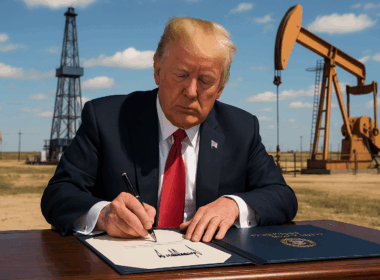
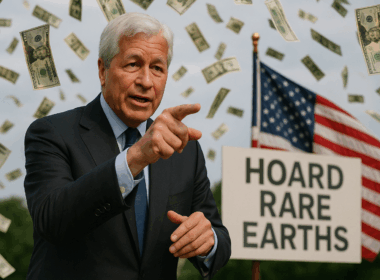




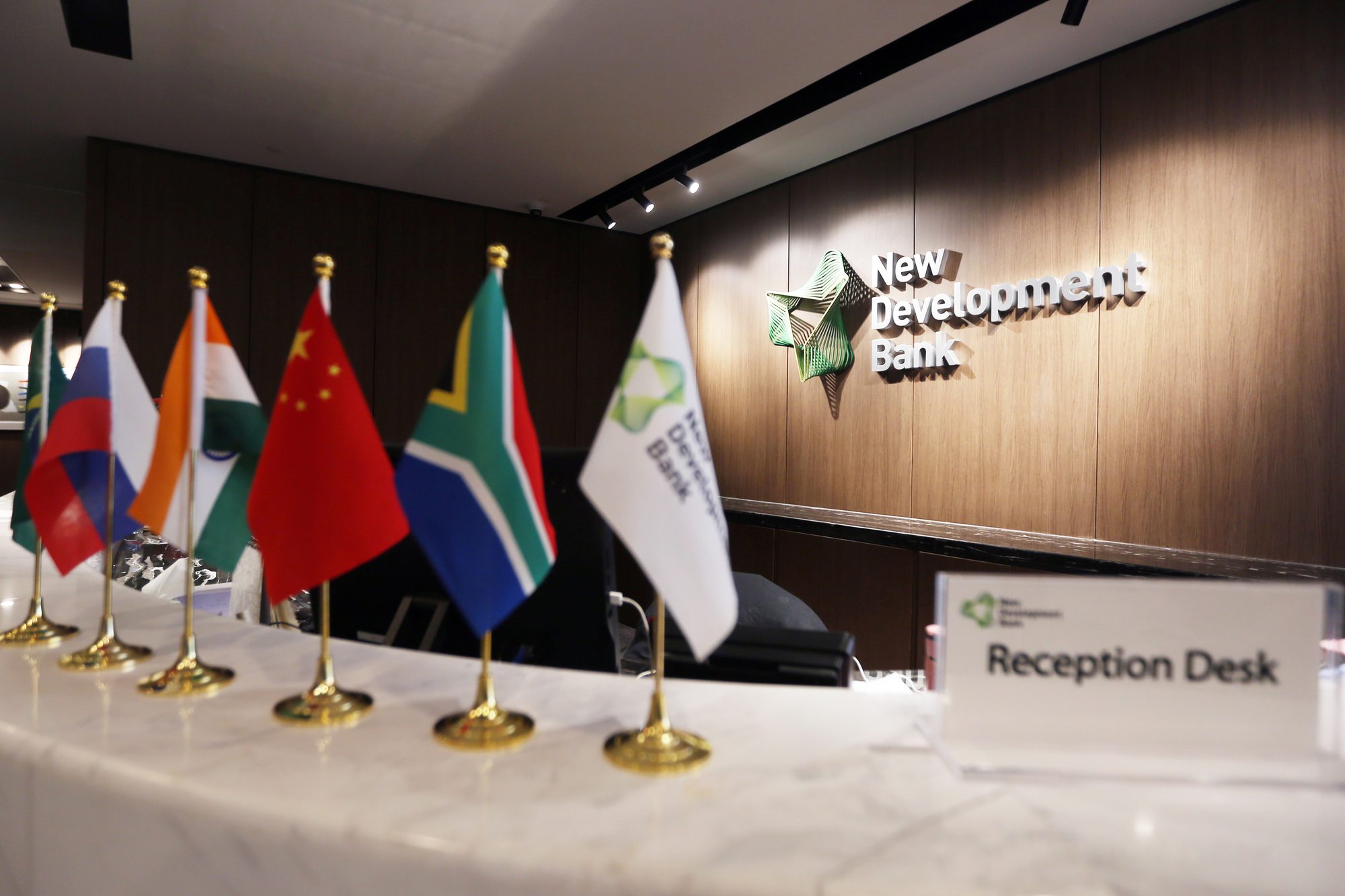
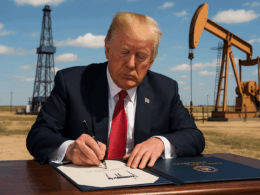
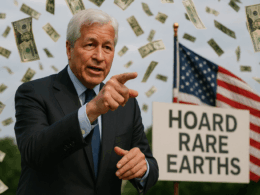


As the war in Ukraine marches on, US/NATO continues to try & alienate Russia from the rest of the world. Unfortunately, one key ally of Russia that keeps coming up is China. Although Biden has said they would sanction China if they helped Russia militarily, they have decided to do it anyway cutting off semi-conductor supplies which is a big bite in China’s future vision & plans.
But why? With major interests in Russian energy, tech & defense, China is inadvertently funding & supporting Russia’s preoccupation in Ukraine even though it remains neutral. So, I think Biden is forcing XI’s hand here to finally choose sides or part ways. If XI decides to retaliate with his own sanctions, his US trade relationship gets even worse & future plans for China go up in smoke.
Another great article by Equedia!.
The following is a quote of information available online. ” The Chinese government—officially known as the People’s Republic of China (PRC)—engages in malicious cyber activities to pursue its national interests. Malicious cyber activities attributed to the Chinese government targeted, and continue to target, a variety of industries and organizations in the United States, including healthcare, financial services, defense industrial base, energy, government facilities, chemical, critical manufacturing (including automotive and aerospace), communications, IT (including managed service providers), international trade, education, video gaming, faith-based organizations, and law firms. Additionally, Advisories published by CISA and other unclassified sources reveal that China is conducting operations worldwide to steal intellectual property and sensitive data from critical infrastructure organizations, including organizations involved in healthcare, pharmaceutical, and research sectors working on COVID-19 response.”
If anything the PRC will escalate their attacks on any country friendly to the USA. We have some great weaknesses here, communications and electrical grids. Other new and dangerous targets unknown to us will be targeted. Apparently many Chinese scientists have been leaving the US to go back to China, due to fear over the widening gap between US citizens attitude towards Chinese people. Many of these scientists received PHD’s from schools in the USA. President Xi will continue to escalate his agenda for China to be number “1” in the World.
We are living in a World under threats from powerful politicians. The World is getting to be more
dangerous every day. It sure would be great if we could all get along with each other. However, that will probably not happen, as politicians are always responsible for escalating the negative.
I think you may be aware that the white hat military are in control of everything that is taking place in the world.. China is working with Trump and other world leaders to destroy the advance of the New World Order and the great reset. Trump has never left office rather is a president in exile after monitoring the 2020 election and is now dimantling every organizational inc. in the world Finace,Judial,Education,Religion,Meical,Pharma,Tech,Media etc..Events are allowed to play out for the purpose of exposing the pedo-human-trafficking elites who have murdered millions of children for sacrifice and drinking of blood!!! I left out HOLLYWOOD lol Do some research on rattletrapp@1776 {Dereck Johnson} to discover how military Law and Oders have ensured that Trump never left because the U.S has been attack from home and foreign nations through the rigged and stolen election
Electricity will be one of the most important and critical component in any situation. Our Electrical Grid cannot be a single grid, it has to be a series of Core Grids, so that we never go down all at once; in any situation, including WAR.
How can we achieve that strategy? By looking at our creative and foreseeing individuals and new green
energy companies, who are working on creating clean, cheap, renewable energy; as no Oil will be coming over the oceans during wartime.
We at ZIPPCELA ENERGY has understood this dilemma and wants to be
part of the equation that will certainly arise, in the foreseeable future.
America has to remain the spear of the Free World.
US leadership in many ways is very healthy; China’s? Quite doubtful. Xi may get sick or even die. Who takes his place if every rival has been pushed out? I am not worried as the US is prepared in a few years to be much stronger that it is today.
The BIG sky is missing! Unseen by short, small, visions. Good over evil prevails, always!
Its functioning is quite simple – all living-forms is eager to realize; consciousness, bliss, purpose. Leading to necessity of consciousness advancing ever unfolding higher n higher revealing unthinkable vistas of life not perceivable by lower level consciousness. The great attraction~force of LOVE causes a uniting, combining of every atom known and unknown. To accomplish this desire for destruction of any aspect fall away as consciousness advances n expands.
A time and existence is approaching where all forms of existence (man included) will adhere to lovingly protect life in all. We live in a beautiful existence!
? Will Elon Musk
Be fueled with the desire to become – President of the US – in an unseen visionary way?
He has the desire of planetary control for egotistical ambitions?